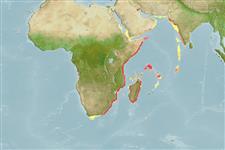Common names from other countries
>
Acanthuriformes (Surgeonfishes) >
Ephippidae (Spadefishes, batfishes and scats)
Etymology: Tripterodon: Greek, tres tria = three + Greek, pteron = wing, fin + Greek, odous = teeth (Ref. 45335).
Environment: milieu / climate zone / depth range / distribution range
Ecologia
marinhas associadas(os) a recifes; intervalo de profundidade 40 - 70 m (Ref. 123860). Tropical
Indian Ocean: southern Africa to Algoa Bay, South Africa; to the Andaman and Nicobar Islands, including India and Sri Lanka.
Tamanho / Peso / Idade
Maturity: Lm ? range ? - ? cm
Max length : 75.0 cm TL macho/indeterminado; (Ref. 30573); common length : 30.0 cm TL macho/indeterminado; (Ref. 30573)
Descrição suscinta
Chaves de identificação | Morfologia | Morfometria
Espinhos dorsais (total) : 9; Raios dorsais (total) : 19 - 21; Espinhos anais: 3; Raios anais : 15 - 17. Silvery brown; with dark crossbands that disappear with growth (Ref. 5327).
Inhabits coastal waters around reefs (Ref. 30573). Feeds on rock and coral-dwelling organisms (Ref. 5213). Flesh edible (Ref. 12484).
Ciclo de vida ou comportamento de acasalamento
Maturities | Reprodução | Spawnings | Egg(s) | Fecundities | Larvas
Smith, M.M., 1986. Ephippidae. p. 605-607. In M.M. Smith and P.C. Heemstra (eds.) Smiths' sea fishes. Springer-Verlag, Berlin. (Ref. 5327)
Status na Lista Vermelha da UICN (Ref. 130435)
CITES (Ref. 128078)
Not Evaluated
Ameaça para os humanos
Harmless
Uso pelos humanos
Pescarias: espécies comerciais; peixe esportivo: sim
Ferramentas
Relatórios especiais
Baixar XML
Fontes da internet
Estimates based on models
Preferred temperature (Ref.
115969): 23.9 - 27.6, mean 26.8 (based on 86 cells).
Índice de diversidade filogenética (Ref.
82804): PD
50 = 1.0000 [Uniqueness, from 0.5 = low to 2.0 = high].
Bayesian length-weight: a=0.02692 (0.01137 - 0.06373), b=2.94 (2.74 - 3.14), in cm Total Length, based on LWR estimates for this (Sub)family-body shape (Ref.
93245).
Nível Trófico (Ref.
69278): 3.5 ±0.37 se; based on food items.
Resiliência (Ref.
120179): Baixo, tempo mínimo de duplicação da população 4,5 - 14 anos (Preliminary K or Fecundity.).
Fishing Vulnerability (Ref.
59153): Moderate to high vulnerability (50 of 100).
